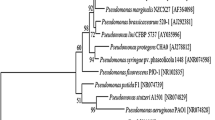Abstract
Pseudonocardia autotrophica was previously identified to produce a toxicity-reduced and solubility-improved disaccharide-containing anti-fungal compound belonging to the tetraene-family, Nystatin-like Pseudonocardia Polyene A1 (NPP A1). Subsequently NPP B1, a novel derivative harboring a heptaene core structure, was produced by a pathway-engineered Pseudonocardia strain through inactivation of the specific enoly reductase gene domain in the NPP biosynthetic gene cluster. Although in vitro and in vivo efficacy and toxicity studies indicate that NPP B1 is a promising lead antifungal compound, further improvement is required to increase the extremely low production yield in the pathway-engineered strain. To overcome this challenge, we performed the N-methyl-N′-nitro-N-nitrosoguanidine (NTG) iterative random mutagenesis, followed by zone-of-inhibition agar plug assay. After three rounds of the mutagenesis-and-screening protocol, the production yield of NPP B1 increased to 6.25 mg/L, which is more than an eightfold increase compared to the parental strain. The qRT-PCR analysis revealed that transcripts of the NPP B1 biosynthetic genes were increased in the mutant strain. Interestingly, an endogenous 125-kb plasmid was found to be eliminated through this mutagenesis. To further improve the NPP B1 production yield, the 32-kb NPP-specific regulatory gene cluster was cloned and overexpressed in the mutant strain. The chromosomal integration of the extra copy of the six NPP-specific regulatory genes led to an additional increase of NPP B1 yield to 31.6 mg/L, which is the highest production level of NPP B1 ever achieved by P. autotrophica strains. These results suggest that a synergistic combination of both the traditional and genetic strain improvement approaches is a very efficient strategy to stimulate the production of an extremely low-level metabolite (such as NPP B1) in a pathway-engineered rare actinomycetes strain.





Similar content being viewed by others
References
Enoch DA, Ludlam HA, Brown NM (2006) Invasive fungal infections: a review of epidemiology and management options. J Med Microbiol 55:809–818
Brautaset T, Sletta H, Degnes KF, Sekurova ON, Bakke I, Volokhan O, Andreassen T, Ellingsen TE, Zotchev SB (2011) New nystatin-related antifungal polyene macrolides with altered polyol region generated via biosynthetic engineering of Streptomyces noursei. Appl Environ Microbiol 77(18):6636–6643
Power P, Dunne T, Murphy B, Nic Lochlainn L, Rai D, Borissow C, Rawlings B, Caffrey P (2008) Engineered synthesis of 7-Oxo- and 15-Deoxy-15-Oxo-amphotericins: insights into structure–activity relationships in polyene antibiotics. Chem Biol 15:78–86
Murphy B, Anderson K, Borissow C, Caffrey P, Griffith G, Hearn J, Ibrahim O, Khan N, Lamburn N, Lee M, Pugh K, Rawlings B (2010) Isolation and characterisation of amphotericin B analogues and truncated polyketide intermediates produced by genetic engineering of Streptomyces nodosus. Org Biomol Chem 8(16):3758
Gray KC, Palacios DS, Dailey I, Endo MM, Uno BE, Wilcock BC, Burke MD (2012) Amphotericin primarily kills yeast by simply binding ergosterol. Proc Natl Acad Sci 109(7):2234–2239
Lee M-J, Kong D, Han K, Sherman DH, Bai L, Deng Z, Lin S, Kim E-S (2012) Structural analysis and biosynthetic engineering of a solubility-improved and less-hemolytic nystatin-like polyene in Pseudonocardia autotrophica. Appl Microbiol Biotechnol 95(1):157–168
Bruheim P, Borgos SEF, Tsan P, Sletta H, Ellingsen TE, Lancelin J-M, Zotchev SB (2004) Chemical diversity of polyene macrolides produced by Streptomyces noursei ATCC 11455 and recombinant strain ERD44 with genetically altered polyketide synthase NysC. Antimicrob Agents Chemother 48(11):4120–4129
Carmody M, Murphy B, Byrne B, Power P, Rai D, Rawlings B, Caffrey P (2005) Biosynthesis of amphotericin derivatives lacking exocyclic carboxyl groups. J Biol Chem 280(41):34420–34426
Kim H-J, Han C-Y, Park J-S, Oh S-H, Kang S-H, Choi S-S, Kim J-M, Kwak J-H, Kim E-S (2018) Nystatin-like Pseudonocardia polyene B1, a novel disaccharide-containing antifungal heptaene antibiotic. Sci Rep. https://doi.org/10.1038/s41598-018-31801-y
Kim B-G, Lee M-J, Seo J, Hwang Y-B, Lee M-Y, Han K, Sherman DH, Kim E-S (2009) Identification of functionally clustered nystatin-like biosynthetic genes in a rare actinomycetes, Pseudonocardia autotrophica. J Ind Microbiol Biotechnol 36(11):1425–1434
Kim H-J, Kim M-K, Lee M-J, Won H-J, Choi S-S, Kim E-S, Hoskisson P (2015) Post-PKS tailoring steps of a disaccharide-containing polyene NPP in Pseudonocardia autotrophica. PLOS One 10(4):e0123270
Somchit MN, Reezal I, Elysha Nur I, Mutalib AR (2003) In vitro antimicrobial activity of ethanol and water extracts of Cassia alata. J Ethnopharmacol 84(1):1–4
Kim H-J, Kim M-K, Kim Y-W, Kim E-S (2014) Effect of antibiotic down-regulatory gene wblA ortholog on antifungal polyene production in rare actinomycetes Pseudonocardia autotrophica. J Microbiol Biotechnol 24(9):1226–1231
Pyeon H, Nah H-J, Kang S-H, Choi S-S, Kim E-S (2017) Heterologous expression of pikromycin biosynthetic gene cluster using Streptomyces artificial chromosome system. Microb Cell Factor. https://doi.org/10.1186/s12934-017-0708-7
Adrio JL, Demain AL (2006) Genetic improvement of processes yielding microbial products. FEMS Microbiol Rev 30(2):187–214
Jeon H-G, Seo J, Lee M-J, Han K, Kim E-S (2011) Analysis and functional expression of NPP pathway-specific regulatory genes in Pseudonocardia autotrophica. J Ind Microbiol Biotechnol 38(4):573–579
Acknowledgements
This work was supported by the National Research Foundation of Korea (NRF) grant funded by the Korean government (MSIP) (NRF-2017R1A2A2A05069859), and also funded by Agricultural Microbiome R&D Program, Ministry of Agriculture, Food and Rural Affairs, Republic of Korea (as part of the (multi-ministerial) Genome Technology to Business Translation Program). No. 918008-04.
Author information
Authors and Affiliations
Corresponding author
Additional information
Publisher's Note
Springer Nature remains neutral with regard to jurisdictional claims in published maps and institutional affiliations.
Electronic supplementary material
Below is the link to the electronic supplementary material.
Rights and permissions
About this article
Cite this article
Han, CY., Jang, JY., Kim, HJ. et al. Pseudonocardia strain improvement for stimulation of the di-sugar heptaene Nystatin-like Pseudonocardia polyene B1 biosynthesis. J Ind Microbiol Biotechnol 46, 649–655 (2019). https://doi.org/10.1007/s10295-019-02149-7
Received:
Accepted:
Published:
Issue Date:
DOI: https://doi.org/10.1007/s10295-019-02149-7




